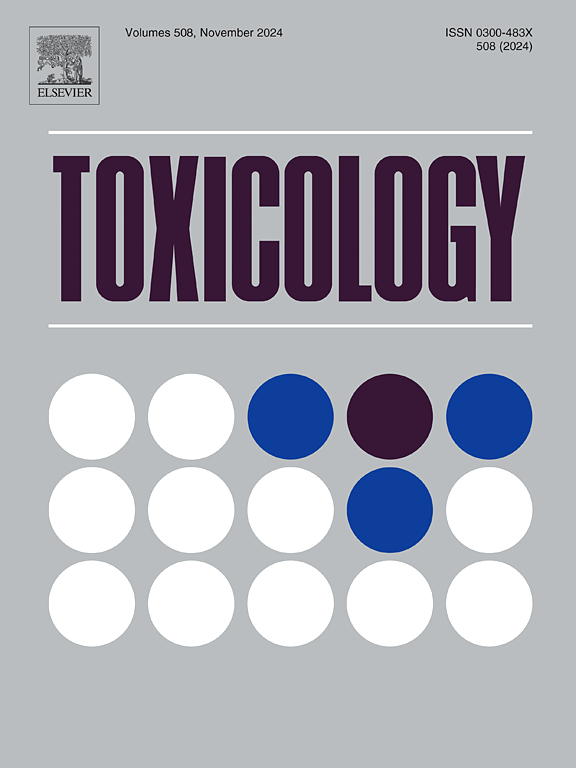Perinatal neurodevelopmental effects of endocrine disruptors: Insights from metabolome mapping in the rat hippocampus
IF 4.6
3区 医学
Q1 PHARMACOLOGY & PHARMACY
引用次数: 0
Abstract
Metabolism is critical for neurodevelopment, yet the mechanisms by which endocrine-disrupting chemicals (EDCs) contribute to neurodevelopmental disorders remain poorly defined. Using a rat model, we investigated hippocampal metabolomic responses at postnatal day 6 following maternal exposure to six structurally diverse EDCs (bisphenol F, permethrin, butyl benzyl phthalate, triphenyl phosphate, perfluorooctane sulfonic acid, and DINCH) from pre-mating through lactation. Targeted steroid, thyroid, and neurosteroid hormones, neurotransmitters, and untargeted lipidomics were profiled to map disrupted pathways. The analysis revealed sex-specific, chemical-specific, and shared metabolic signatures of developmental neurotoxicity. Key affected endpoints across chemicals included corticosterone, pregnenolone sulfate, and N-acylethanolamine lipids, confirming hormonal disruption while uncovering novel non-EATS (estrogen, androgen, thyroid, and steroidogenesis) pathways and mechanisms of action. These findings provide new insights into EDC-mediated disruption of hippocampal development and identify potential molecular biomarkers that may support future mechanistic research and chemical risk assessment.
围产期内分泌干扰物对神经发育的影响:来自大鼠海马代谢组图谱的见解。
代谢对神经发育至关重要,但内分泌干扰化学物质(EDCs)导致神经发育障碍的机制仍不清楚。利用大鼠模型,我们研究了母鼠从交配前到哺乳期暴露于六种结构不同的EDCs(双酚F、氯菊酯、邻苯二甲酸丁苯酯、磷酸三苯酯、全氟辛烷磺酸和丁二酚)后出生第6天的海马代谢组学反应。靶向类固醇,甲状腺和神经类固醇激素,神经递质和非靶向脂质组学被描述为绘制中断的途径。分析揭示了发育性神经毒性的性别特异性、化学特异性和共享的代谢特征。化学物质的关键影响终点包括皮质酮、孕烯醇酮硫酸盐和n-酰基乙醇胺脂质,证实了激素破坏,同时发现了新的非eats(雌激素、雄激素、甲状腺和类固醇)途径和作用机制。这些发现为edc介导的海马发育破坏提供了新的见解,并确定了潜在的分子生物标志物,可能支持未来的机制研究和化学风险评估。
本文章由计算机程序翻译,如有差异,请以英文原文为准。
求助全文
约1分钟内获得全文
求助全文
来源期刊

Toxicology
医学-毒理学
CiteScore
7.80
自引率
4.40%
发文量
222
审稿时长
23 days
期刊介绍:
Toxicology is an international, peer-reviewed journal that publishes only the highest quality original scientific research and critical reviews describing hypothesis-based investigations into mechanisms of toxicity associated with exposures to xenobiotic chemicals, particularly as it relates to human health. In this respect "mechanisms" is defined on both the macro (e.g. physiological, biological, kinetic, species, sex, etc.) and molecular (genomic, transcriptomic, metabolic, etc.) scale. Emphasis is placed on findings that identify novel hazards and that can be extrapolated to exposures and mechanisms that are relevant to estimating human risk. Toxicology also publishes brief communications, personal commentaries and opinion articles, as well as concise expert reviews on contemporary topics. All research and review articles published in Toxicology are subject to rigorous peer review. Authors are asked to contact the Editor-in-Chief prior to submitting review articles or commentaries for consideration for publication in Toxicology.
 求助内容:
求助内容: 应助结果提醒方式:
应助结果提醒方式:


